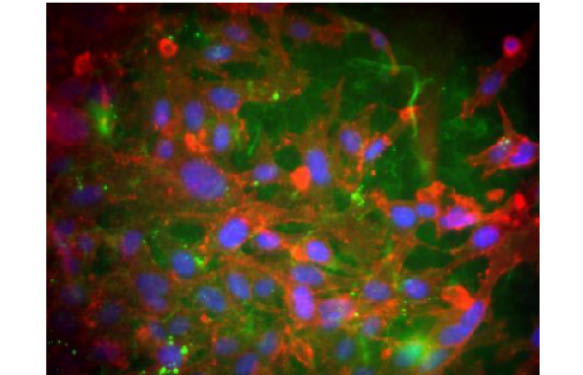 Signal-Seeker assays (Cytoskeleton Inc.) provide researchers with the most comprehensive reagents enabling highly sensitive and specific detection of the key Post Translational Modifications (PTMs) of your Protein of Interest.
Signal-Seeker assays (Cytoskeleton Inc.) provide researchers with the most comprehensive reagents enabling highly sensitive and specific detection of the key Post Translational Modifications (PTMs) of your Protein of Interest.
In this post, I invite you to look at experimental results obtained with these unique assays for the characterization of Tyrosine Phosphorylation, Ubiquitination, SUMOylation and Acetylation of endogenous proteins.
In many cases, PTMs have been shown to orchestrate a specific protein function, and recent studies have suggested that both cooperative and negative PTM crosstalk is a pervasive and fundamental cell regulatory mechanism (as shown in the table below). Importantly for human health and disease, dysregulation of PTMs has been implicated in the progression of diseases like cancer, heart failure, and neurologic and metabolic diseases.

The Signal-Seeker technology is based on affinity beads to enrich post-translationally modified proteins from cell or tissue lysates (you might like to look at our previous post in which the the Signal-Seeker method is described ).
Quality affinity reagents are key to allowing enrichment of often very transient and low level modified species. The affinity beads developed by the scientists at Cytoskeleton Inc. are highly optimized to maximize the probability of identifying key regulatory modifications of even the rarest species. The enriched protein population is then analyzed by standard Western Blotting for identifying the protein of interest with a target-specific primary antibody. This approach enables convenient analysis of the PTM status of your protein(s) of interest.
Now, let’s take a look at Signal-Seeker kits in action!
Post Translational Modification – example with Protein Tyrosine Phosphorylation analysis & Signal-Seekers

Tyrosyl Rac1 levels were consistently shown to dip over the first minute of EGF stimulation (repeated 5 times). Interestingly, Rac1 activation, shown in Figure 1B, increased as Rac1 tyrosyl phosphorylation decreased. This observation supports a model that has previously been suggested for kinase regulation of Ras GTPase activity. (1)
Figure 1C shows the total phosphotyrosine signal during EGF stimulation and Figure 1D shows that equal amounts of lysate were used for each IP and activation reaction (10 μl of each lysate was run and analysed by WB using an anti-tubulin antibody (T) and an anti-Rac1 antibody (R) – Arrowhead points to total Rac1 signal from 3% of input lysate).
Post Translational Modification involving Protein Ubiquitination

What if Post Translational Modification is SUMOylation 2/3
As for the previous assays, this Signal Seeker SUMOylation Enrichment kit is based on the use of Protein G beads conjugated with antibody anti-SUMO2/3 (clone 11G2) (Cat. nr ASM24). The affinity bead has been shown to immunoprecipitate a wide range of SUMO-2/3 targeted proteins in A431 cell lysate, and the affinity bead reagent has been optimized to give no detectable leaching of either heavy or light chains in an IP assay, making the resulting data extremely specific, sensitive and clean (Fig. 3). The detection of endogenous mono– and poly-SUMOylated proteins is visualized with characteristic multiple bands in Western Blot (Fig. 3).
Fig 3A: Enrichment of SUMO 2/3 conjugates from endogenous total proteins Fig 3B: Enrichment of SUMO 2/3 conjugates from endogenous p53
A431 cell lysates were prepared as described in this protocol from HS43 and CT37 (HS43: Heat Shock treated (43°C for 10min), CT37: untreated). SUMO-2/3 conjugates were enriched from 1mg of lysate and immuno-blotted by anti-SUMO-2/3 antibody (Clone: 12F3)(Cat. nr ASM23) (Fig. 3A) and anti-p53 antibody (Fig. 3B) along with control beads. The level of total SUMO-2/3 conjugates in heat shock treated cells (Fig3A: SUMO 2/3 Affinity Beads Lane 43HS) is stronger than control cells (Fig. 3A: SUMO 2/3 Affinity Beads Lane 37CT). Total SUMOylated protein signal is delineated by the blue bracket, the blue arrowhead indicates the position of free SUMO 2/3.
The well-studied SUMO-2/3 target protein, tumor suppressor p53 was immuno-blotted (Fig. 3B). Pound (#) and bracket({) indicate mono- and poly- SUMOylated p53 proteins, respectively. SUMO-2/3 unmodified p53,denoted by star(*) and may be due to non-specific bead binding (see control bead lanes) or deSUMOylation events during immunoprecipitation.
This representative data agrees with published data and demonstrates the utility of SUMO-2/3 affinity beads and Signal-Seeker™ kits in studying the rapidly growing area of SUMOmodification of proteins (4).
Acetyl-Lysine as Post Translational Modification
This Signal-Seeker Acetyl-Lysine Detection Kit, is composed of the Acetyl Lysine Affinity beads (Cat. nr AAC04-beads) made by a proprietary mixture of anti-acetyl-lysine antibodies, AAC02 and AAC03, covalently crosslinked to protein G beads. Both of this anti-acetyl-lysine antibodies were developed by Cytoskeleton’s researchers from 20 acetyl-lysine hybridoma clones and selected based on their superior acetyl-lysine protein enrichment ability. Acetyl-lysine Affinity Beads are a powerful tool for the analysis of total and/or target protein acetylation.
Data in Figure 4 shows the detection of endogenous acetyl-lysine modified proteins from Cos7 cells treated with 1uM TSA and 1mM nicotinamide for 6 hours using AAC04-beads as well as other commercially available anti-acetyl-lysine reagents. Normal mouse IgG control was also used to account for non-specific enrichment of acetylated proteins.

Various acetyl-lysine affinity reagents were used to IP acetylated proteins from Cos-7 cells either treated (+) or untreated (-) with TSA (1uM) and nicotinamide (1mM) for 6 hours. (1) 16.7ul of AAC04 bead slurry (20ug antibody). (2) 50ul of AAC04 bead slurry (60ug antibody). (3) Antiacetyl lysine rabbit monoclonal mix (Cell Signaling, 1:100 per manufacturer’s instruction). (4) ImmuneChem acetyl lysine affinity bead (40ug antibody). (5) ImmunChem acetyl lysine bead (80ug antibody). (6) Normal mouse IgG control bead (60ug antibody). The total profile of enriched acetylated proteins were eluted and analyzed by western blot with an AAC03-HRP antibody (1:3000). AAC04 performed exceptionally well in enriching a broad range of acetylated proteins whereas the other commercial acetyl lysine enrichment reagents only enriched the most abundance acetylated proteins (e.g. acetylated tubulin and histones).
What about you?
Which Post Translational Modifications (PTM) are you analyzing, which protocol are you using? Are you interested in using the Signal-Seeker technology for your protein of interest? Share your comments, thoughts and questions below or contact directly your local tebu-bio office.
References:
Protoc. 9(4):896-909





